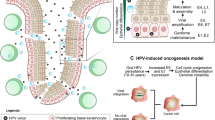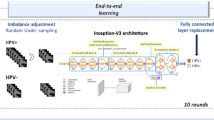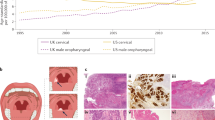Abstract
Background
Oropharyngeal squamous cell carcinoma (OPSCC) of human papillomavirus (HPV)-positive status is increasing relative to HPV-negative disease. Nutritional features of OPSCC patients according to HPV status is unclear.
Subjects/methods
Canadian and Spanish patients with OPSCC were assessed for body mass index (BMI), weight loss grade (WLG), and computed tomography-defined skeletal muscle index (SMI). Chi-square, t-test, Mann-Whitney-U, Kruskal-Wallis tests were conducted to compare HPV positive and negative groups. Overall survival (OS) was assessed by univariable Kaplan–Meier and Cox proportional hazard methods.
Results
No differences in BMI, WLG, SMI, and adipose tissue index between the 308 (Canada) and 134 (Spain) patients according to HPV status; hence cohorts were pooled (n = 442). HPV-positive patients (n = 317) were overweight/obese (72.8%), had WLG of 0/1 (59.6%) and high SMI (83.4%) while HPV-negative patients were normal/underweight (61.5%), had high WLG 3/4 (50.8%), and moderate/severe SMI depletion (46.9%) (p < 0.003). These overall differences notwithstanding, there was crossover i.e. 35% of HPV-positive patients had high WLG and/or moderate/severe muscle depletion and 29% of HPV-negative patients had minimal weight loss and high SMI. HPV-negative patients had a higher risk of mortality (HR 3.78, 95% CI 2.70–5.29, P < 0.001) and this difference was retained after multivariable adjustment for WLG, SMI, age, disease stage, and planned treatment (HR 3.30, 95% CI 2.17–5.02, P < 0.001).
Conclusion
Nutrition features of patients with OPSCC did not differ between Canada and Spain. Distinctive nutrition features exist in patients according to HPV status. The high heterogeneity of individual nutritional profiles invites an individualized approach to nutrition care.
This is a preview of subscription content, access via your institution
Access options
Subscribe to this journal
Receive 12 print issues and online access
269,00 € per year
only 22,42 € per issue
Buy this article
- Purchase on SpringerLink
- Instant access to full article PDF
Prices may be subject to local taxes which are calculated during checkout




Similar content being viewed by others
Data availability
The data that support the findings of this study are available on request from both corresponding authors, LA and VB. The data are not publicly available due to restrictions related to the participant’s privacy.
References
Lechner M, Liu J, Masterson L, Fenton TR. HPV-associated oropharyngeal cancer: epidemiology, molecular biology and clinical management. Nat Rev Clin Oncol. 2022;19:306–27.
Ferris RL, Westra W. Oropharyngeal carcinoma with a special focus on HPV-related squamous cell carcinoma. Annu Rev Pathol. 2023;18:515–35.
Carlander AF, Jakobsen KK, Bendtsen SK, Garset-Zamani M, Lynggaard CD, Jensen JS. et al. A contemporary systematic review on repartition of HPV-positivity in oropharyngeal cancer worldwide. Viruses. 2021;13:1326
Zanoni DK, Patel SG, Shah JP. Changes in the 8th edition of the American Joint Committee on Cancer (AJCC) staging of head and neck cancer: rationale and implications. Curr Oncol Rep. 2019;21:52.
Cui M, Cheng J, Cheng H, Zhao M, Zhou D, Zhang M, et al. Characteristics of human papillomavirus infection among oropharyngeal cancer patients: a systematic review and meta-analysis. Arch Oral Biol. 2024;157:105830.
Ang KK, Harris J, Wheeler R, Weber R, Rosenthal DI, Nguyen-Tân PF, et al. Human papillomavirus and survival of patients with oropharyngeal cancer. NEJM. 2010;363:24–35.
Findlay M, White K, Stapleton N, Bauer J. Is sarcopenia a predictor of prognosis for patients undergoing radiotherapy for head and neck cancer? A meta-analysis. Clin Nutr. 2021;40:1711–8.
Karsten RT, Chargi N, van der Molen L, van Son RJJH, de Bree R, Al-Mamgani A, et al. Dysphagia, trismus and speech impairment following radiation-based treatment for advanced stage oropharyngeal carcinoma: a one-year prospective evaluation. Eur Arch Otorhinolaryngol. 2022;279:1003–27.
Edwards A, Brown T, Hughes BGM, Bauer J. The changing face of head and neck cancer: are patients with human papillomavirus-positive disease at greater nutritional risk? A systematic review. Support Care Cancer 2022;30:7191–204.
Saroul N, Martraix C, Mulliez A, Cassagnes L, Puechmaille M, Bernadach M, et al. Impact of HPV status on nutritional status during radio chemotherapy for oropharyngeal cancer. Cancer Radiother. 2023;27:42–9.
Harrowfield J, Isenring E, Kiss N, Laing E, Lipson-Smith R, Britton B. The impact of human papillomavirus (HPV) associated oropharyngeal squamous cell carcinoma (OPSCC) on nutritional outcomes. Nutrients. 2021;13:1–14.
Martin L, Senesse P, Gioulbasanis I, Antoun S, Bozzetti F, Deans C, et al. Diagnostic criteria for the classification of cancer-associated weight loss. J Clin Oncol. 2015;33:90–9.
Hua X, Liu S, Liao JF, Wen W, Long ZQ, Lu ZJ. et al. When the loss costs too much: a systematic review and meta-analysis of sarcopenia in head and neck cancer. Front Oncol. 2020;9:1561
Chargi N, Bril SI, Swartz JE, Wegner I, Willems SW, de Bree R. Skeletal muscle mass is an imaging biomarker for decreased survival in patients with oropharyngeal squamous cell carcinoma. Oral Oncol. 2020;101:104519.
Findlay M, White K, Brown C, Bauer JD. Nutritional status and skeletal muscle status in patients with head and neck cancer: Impact on outcomes. J Cachexia Sarcopenia Muscle. 2021;12:2187–98.
Edwards A, Hughes BGM, Brown T, Bauer J. Prevalence and impact of computed tomography–defined sarcopenia on survival in patients with human papillomavirus–positive oropharyngeal cancer: a systematic review. Adv Nutr. 2022;13:2433–44.
Habbous S, Chu KP, Lau H, Schorr M, Belayneh M, Ha MN, et al. Human papillomavirus in oropharyngeal cancer in Canada: analysis of 5 comprehensive cancer centres using multiple imputation. CMAJ. 2017;189:E1030–E1040.
Edge SB, Compton CC. The American joint committee on cancer: the 7th edition of the AJCC cancer staging manual and the future of TNM. Ann Surg Oncol. 2010;17:1471–4.
Martin L, Muscaritoli M, Bourdel-Marchasson I, Kubrak C, Laird B, Gagnon B, et al. Diagnostic criteria for cancer cachexia: reduced food intake and inflammation predict weight loss and survival in an international, multi-cohort analysis. J Cachexia Sarcopenia Muscle. 2021;12:1189–202.
Kubrak C, Martin L, Grossberg AJ, Olson B, Ottery F, Findlay M, et al. Quantifying the severity of sarcopenia in patients with cancer of the head and neck. Clin Nutr. 2024;43:989–1000.
Oken MM, Creech RH, Tormey DC, Horton J, Davis TE, McFadden ET, et al. Toxicity and response criteria of the Eastern Cooperative Oncology Group. Am J Clin Oncol. 1985;5:649–55.
Jager-Wittenaar H, de Bats HF, Welink-Lamberts BJ, Gort-van Dijk D, van der Laan BFAM, Ottery FD, et al. Self-completion of the Patient-generated subjective global assessment short form is feasible and is associated with increased awareness on malnutrition risk in patients with head and neck cancer. Nutr Clin Pract. 2020;35:353–62.
Prado CMM, Birdsell LA, Baracos VE. The emerging role of computerized tomography in assessing cancer cachexia. Curr Opin Support Palliat Care. 2009;3:269–75.
Martin L, Birdsell L, MacDonald N, Reiman T, Clandinin MT, McCargar LJ, et al. Cancer cachexia in the age of obesity: Skeletal muscle depletion is a powerful prognostic factor, independent of body mass index. J Clin Oncol. 2013;31:1539–47.
Weaver B, Wuensch KL. SPSS and SAS programs for comparing Pearson correlations and OLS regression coefficients. Behav Res Methods. 2013;45:880–95.
de Oliveira Faria S, Hueniken K, Kunaratnam V, Hui Huang S, Goldstein D, Ringash J, et al. Associations between human papillomavirus status, weight change, and survival of oropharyngeal cancer patients. Nutr Cancer. 2023;75:1541–50.
Thakral A, Lee JJ, Hou T, Hueniken K, Dudding T, Gormley M, et al. Smoking and alcohol by HPV status in head and neck cancer: a Mendelian randomization study. Nat Commun. 2024;15:1–9.
von Buchwald C, Jakobsen KK, Carlander AF, Tous S, Grønhøj C, Rasmussen JH, et al. HNCIG-EPIC group. TNM 8 staging system beyond p16: double HPV/p16 status is superior to p16 alone in predicting outcome in oropharyngeal squamous cell carcinoma. Eur J Cancer. 2024;211:114329.
Acknowledgements
We would like to express our sincere gratitude to all the patients for their participation in this project. We wish to thank all the members of the research team who contributed to the successful completion of this study. Their technical assistance, critical advice, and dedication have been instrumental in the accomplishment of our research objectives.
Funding
Instituto de Salud Carlos III has funded MC through the grant FI20/00103 (Co-founded by European Social Foundation ESF investing in your future). The rest of the authors did not receive financial support from any organization for the present work.
Author information
Authors and Affiliations
Contributions
The authors confirm contribution to the paper as follows: study conception and design: VB, RM, LA, MC, CK; data collection: MC, CK, LA, VB; analysis and interpretation of results: MC, CK, VB; draft manuscript preparation: MC, CK, VB, LA. VB, RM, LA, MC, CK, FM, JB, ST, BQ, XW, MAP, MG, MT, LA, MO, MM, NJ, RS, BD, NC, JW reviewed the results and approved the final version of the manuscript.
Corresponding authors
Ethics declarations
Competing interests
The authors declare no competing interests.
Ethics approval and consent to participate
The present study was developed according to the Declaration of Helsinki and have the ethical approval from the institutional research ethics boards from both countries. For Spain was the Hospital Universitari de Bellvitge Ethics Committee for Clinical Research with the protocol number PR138/19. An informed consent was obtained from all patients included in the Spanish cohort. And for Canada, the Health Research Ethics Board of Alberta (HREBA)—Cancer with the protocol number CC_17-0433. The HREBA approved waiver of an informed consent for the Canadian cohort.
Additional information
Publisher’s note Springer Nature remains neutral with regard to jurisdictional claims in published maps and institutional affiliations.
Supplementary information
Rights and permissions
Springer Nature or its licensor (e.g. a society or other partner) holds exclusive rights to this article under a publishing agreement with the author(s) or other rightsholder(s); author self-archiving of the accepted manuscript version of this article is solely governed by the terms of such publishing agreement and applicable law.
About this article
Cite this article
Choulli, M., Kubrak, C., Morey, F. et al. Nutritional characterization of patients with oropharyngeal cancers: impact of human papillomavirus status. Eur J Clin Nutr 79, 467–474 (2025). https://doi.org/10.1038/s41430-024-01556-z
Received:
Revised:
Accepted:
Published:
Issue Date:
DOI: https://doi.org/10.1038/s41430-024-01556-z



